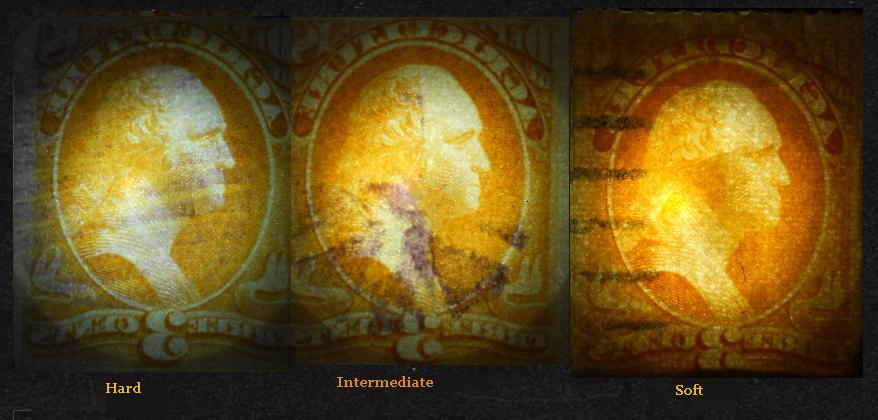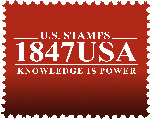The U.S. Bank Note
Paper Types
By Bob Allen
For the purposes of identifying the US number of the U.S. Bank Note issues it is necessary to be able to distinguish between only two paper types, a hard, white, somewhat crackly paper that is referred to by most philatelists, including this web site, as "hard white" and an off-white, "soft porous" paper. The "hard white" type of paper was used by both the National and Continental Bank Note Companies (US 134-181) and the "soft porous" type of paper by the American Bank Note Company (US 182-245), although the Continental Bank Note Company did print some of its stamps on the "soft porous" paper. In many cases simply identifying the paper type will yield the US number. The two paper types are illustrated below. Note the heavily mottled look of the "soft porous" stamp printed on the American Bank Note paper. Although it does not show up well in the scans, the "hard white" paper is also more translucent than the "soft porous" paper, which tends to be quite opaque. The stamp below was printed on the "hard white", woven paper of the National Bank Note Issues. Note that this stamp is fairly common (US 114) and was chosen for its wide margin and the certainty that it was printed by the National Bank Note Company, since all stamps of the 1869 issue were printed by National. (The same paper was used for most Continental printings.)


"Hard White" Paper
The stamp below (US 212) was printed on the "soft porous" paper of the American Bank Note Issues. Note that the poor centering providing two wide margins makes identifying the paper type much easier, something to keep in mind while learning to differentiate the paper types of the Bank Note issues.


"Soft Porous" Paper
 Paper Types
Paper TypesImage Courtesy of Don East
The traditional technique is flicking the stamp near one's ear. A crisp sound will in most cases identify the stamp as being either a National or Continental printing, but a duller sound does not necessarily mean the stamp was printed by the American Bank Note Company.
For most of us the simplest method for determining whether the stamp was printed by the American Bank Note Company is to hold the stamp to a strong light source at various angles and determine whether the paper has a mottled, opaque appearance (see above). If it does, it is American, if not, it is either a National or Continental printing.
If you are unfamiliar with this "mottled" look, find some of the stamps shown in the Bank Note Identifier that have the term "Redesign" in their description. All of these stamps were printed only on the "soft porous" paper. Perhaps easier, all of the of 1893 were printed by the American Bank Note Company on "soft porous" paper and they may prove more useful in getting a feel for the "soft porous" paper. As mentioned, if the stamp has a wide margin or selvage the mottled look is very evident and many of the Columbians do.
Compare these with a stamp from the 1869 Series. Multiple copies of US 114, for example, can be had at nominal cost. (Note that the 1¢ Special Reprint of 1880, US 133, was printed by the American Bank Note Company on the soft porous paper.)
There is perhaps an even better way to determine whether the stamp is the "hard white" or "soft porous" type, but you need to have a good ultraviolet source to see it. The "hard paper" stamps will "shine" a little brighter than their "soft porous" counterparts. although this difference can apparently be seen with the cheaper UV lamps, at least to this observer, the difference is very, very slight. With the more expensive UV lamps this difference is more pronounced.
There are many other differences in paper type, for example "ribbed" paper, the very white paper of the Special Printings and even double paper printings.
For more information on the subject of stamp paper types we recommend the following reading:
Brookman's "The United States Postage Stamps of the 19th Century"
The Stamp Specialist Number Four, James H. Obrig: "Paper. A Non-technical History and Description of the More Common Types as used in Philately" - which includes eight paper samples
Lowell Cooper's "Some Notes Concerning Paper and Paper Mesh on the Bank Notes"
R. H. White's Encyclopedia of the Colors of United States Postage Stamps Volume 6: "Paper and Gums of 1847-1909"
Designs of the Issues of 1870-1888: The Large Bank Notes
Secret Marks and Illustrated Identifiers
Paper Used For United States Stamps
Additional Resources





